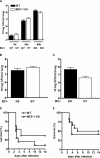Monocyte chemoattractant protein 1 does not contribute to protective immunity against pneumococcal pneumonia
- PMID: 16982835
- PMCID: PMC1698042
- DOI: 10.1128/IAI.00977-06
Monocyte chemoattractant protein 1 does not contribute to protective immunity against pneumococcal pneumonia
Abstract
To determine the role of monocyte chemoattractant protein 1 (MCP-1) during pneumococcal pneumonia, MCP-1 knockout and wild-type mice were infected with Streptococcus pneumoniae. Pulmonary MCP-1 levels were strongly correlated to bacterial loads in wild-type mice. However, MCP-1 knockout and wild-type mice were indistinguishable with respect to bacterial growth, inflammatory responses, and lethality.
Figures



Similar articles
-
Important role for CC chemokine ligand 2-dependent lung mononuclear phagocyte recruitment to inhibit sepsis in mice infected with Streptococcus pneumoniae.J Immunol. 2009 Apr 15;182(8):4931-7. doi: 10.4049/jimmunol.0804096. J Immunol. 2009. PMID: 19342672
-
Monocyte chemoattractant protein 1 contributes to an adequate immune response in influenza pneumonia.Clin Immunol. 2007 Dec;125(3):328-36. doi: 10.1016/j.clim.2007.08.001. Epub 2007 Sep 10. Clin Immunol. 2007. PMID: 17827068
-
CD11b limits bacterial outgrowth and dissemination during murine pneumococcal pneumonia.J Infect Dis. 2005 May 15;191(10):1755-60. doi: 10.1086/429633. Epub 2005 Apr 6. J Infect Dis. 2005. PMID: 15838804
-
Monocyte chemoattractant protein-1.Chem Immunol. 1999;72:7-29. doi: 10.1159/000058723. Chem Immunol. 1999. PMID: 10550927 Review. No abstract available.
-
Monocyte Chemoattractant Protein 1 (MCP-1) in obesity and diabetes.Cytokine. 2012 Oct;60(1):1-12. doi: 10.1016/j.cyto.2012.06.018. Epub 2012 Jul 4. Cytokine. 2012. PMID: 22766373 Free PMC article. Review.
Cited by
-
Polyamine transporter in Streptococcus pneumoniae is essential for evading early innate immune responses in pneumococcal pneumonia.Sci Rep. 2016 Jun 1;6:26964. doi: 10.1038/srep26964. Sci Rep. 2016. PMID: 27247105 Free PMC article.
-
Neutrophil depletion causes a fatal defect in murine pulmonary Staphylococcus aureus clearance.J Surg Res. 2008 Dec;150(2):278-85. doi: 10.1016/j.jss.2008.02.009. Epub 2008 Mar 13. J Surg Res. 2008. PMID: 18621398 Free PMC article.
-
Macrophage Rac2 Is Required to Reduce the Severity of Cigarette Smoke-induced Pneumonia.Am J Respir Crit Care Med. 2018 Nov 15;198(10):1288-1301. doi: 10.1164/rccm.201712-2388OC. Am J Respir Crit Care Med. 2018. PMID: 29897791 Free PMC article.
References
-
- Amano, H., K. Morimoto, M. Senba, H. Wang, Y. Ishida, A. Kumatori, H. Yoshimine, K. Oishi, N. Mukaida, and T. Nagatake. 2004. Essential contribution of monocyte chemoattractant protein-1/C-C chemokine ligand-2 to resolution and repair processes in acute bacterial pneumonia. J. Immunol. 172:398-409. - PubMed
-
- Bernstein, J. M. 1999. Treatment of community-acquired pneumonia-IDSA guidelines. Infectious Diseases Society of America. Chest 115:9S-13S. - PubMed
-
- Bossink, A. W., L. Paemen, P. M. Jansen, C. E. Hack, L. G. Thijs, and J. Van Damme. 1995. Plasma levels of the chemokines monocyte chemotactic proteins-1 and -2 are elevated in human sepsis. Blood 86:3841-3847. - PubMed
-
- Campbell, G. D., Jr. 1999. Commentary on the 1993 American Thoracic Society guidelines for the treatment of community-acquired pneumonia. Chest 115:14S-18S. - PubMed
-
- Daly, C., and B. J. Rollins. 2003. Monocyte chemoattractant protein-1 (CCL2) in inflammatory disease and adaptive immunity: therapeutic opportunities and controversies. Microcirculation 10:247-257. - PubMed
Publication types
MeSH terms
Substances
LinkOut - more resources
Full Text Sources
Molecular Biology Databases
Research Materials
Miscellaneous

